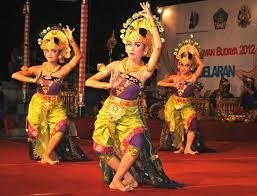Balinese dances are a very ancient dance tradition that is a part of the religious and artistic expression among the Balinese people, native to Bali island, Indonesia. Balinese dance is dynamic, angular and intensely expressive. The Balinese dancers express the story of dance-drama through the whole bodily gestures; fingers, hands and body gestures to head and eyes movements.
There is a great richness of dance forms and styles in Bali; and particularly notable are those ritualistic dance dramas which involve Rangda, the witch and the great beast Barong. Most of dances in Bali are connected to Hindu rituals, such as the Sanghyang Dedari sacred dance than invoked hyang spirits that believed to possess the dancers in trance state during the performance. Other Balinese dances are not linked to religious rituals and created for certain purposes, such as Pendet welcoming dance and Joged dance that is social dance for entertainment purpose.
Significance
In Hinduism, dance is an accompaniment to the perpetual dissolving and reforming of the world. The creative and reproductive balance is often personified as Shiva's wife, Durga, sometimes caled Uma, Parvati, or Kali. This has significance in Balinese Hinduism, since the common figure of Rangda is similar in many ways to Durga.
Variants
In Bali there are various categories of dance, including epic performances such as the omnipresent Mahabharata and Ramayana. Certain ceremonies at village temples feature a special performance of a dance-drama, a battle between the mythical characters Rangda, the witch representing evil, and Barong, the lion or dragon, representing good.
Among the dance traditions in Bali, the following deserve special mention:
Technique
Bali dancers learn the craft as children from their mothers as soon as they are born, in the womb they are played the Balinese music and are taught to dance with their hands before they can walk. Official training as a Bali dancer starts as young as 7. In Balinese dance the movement is closely associated with the rhythms produced by the gamelan, a musical ensemble specific to Java and Bali.[5] Multiple levels of articulations in the face, eyes, hands, arms, hips, and feet are coordinated to reflect layers of percussive sounds.
The number of codified hand positions and gestures, the mudras, is higher in India than in Java or Bali. It has been speculated that they have been forgotten as the dance was transmitted from India to Java. Hand positions and gestures are nonetheless as important inJavanese and Balinese dance as in India. Whether in India, Indonesia or Cambodia, hands have a typically ornamental role and emphasize the dance's delicate intricacy.
References
this is some images and videos of Baliness Dance






